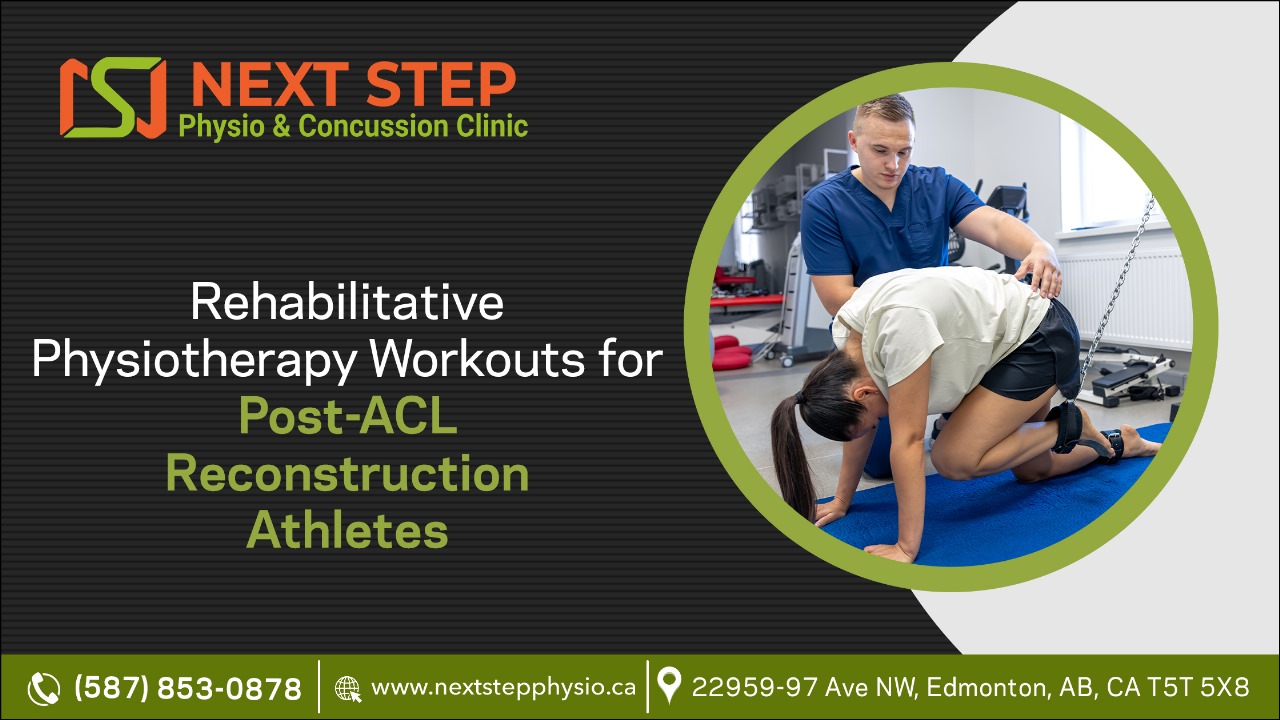ACL (Anterior Cruciate Ligament) injuries frequently occur among athletes engaged in sports that demand sudden stops, changes in direction, or jumping. However, surgery alone is not enough; comprehensive sports physiotherapy Edmonton is specialized for athletes to regain strength, stability, and agility, ultimately enabling a safe return to their sport.
What is ACL Reconstruction?
An ACL tear is a significant knee injury that damages or tears the ligament connecting the knee joint. ACL reconstruction treatment involves replacing the torn ligament with a graft, commonly sourced from either the patient’s body (autograft) or a donor (allograft). The primary goal of this surgery is to restore knee stability, minimize the risk of future damage, and facilitate the rehabilitation process.
Role of Rehabilitation Physiotherapy in ACL Recovery
Rehabilitative sports physiotherapy in Edmonton is crucial in the comprehensive recovery process for athletes undergoing ACL reconstruction surgery. It begins immediately after surgery and progresses through various stages, each designed to address specific aspects of recovery, from pain management to mobility restoration. There are certain phases involved,
Immediate Post-Operative Phase
The Immediate Post-Operative Phase begins immediately after surgery and typically lasts for the first few days to weeks. This phase is crucial for ensuring initial recovery and setting the stage for further rehabilitation. Here are some critical aspects of this phase:
Pain Management and Swelling Reduction:
-
Goal: Manage post-operative pain and reduce swelling around the knee joint to facilitate early mobility.
-
Techniques: Ice therapy, leg elevation, and gentle manual techniques to promote fluid drainage are employed to manage post-operative pain and reduce swelling around the knee joint, facilitating early mobility and aiding in the recovery process.
Restoring Basic Mobility:
-
Goal: Prevent joint stiffness and promote an early range of motion.
- Knee flexion and extension exercises: Aims to improve mobility and strength in the knee joint. These exercises following a knee injury to manage conditions that affect knee flexibility and function.
Early Stage Rehabilitation Exercises
Early-stage rehabilitation exercises help initiate movement, promote healing, and restore function following surgery or injury. These exercises are typically implemented in the days to weeks immediately after the acute post-operative phase. Here are critical aspects of early-stage rehabilitation exercises:
Range of Motion Exercises:
-
Goal: Restore the full range of motion in the knee joint.
-
Exercises: The range-of-motion exercises include active knee movements, ankle pumps, calf stretches, and gentle stretching exercises.
Quadriceps Sets and Straight Leg Raises:
-
Goal: Prevent muscle atrophy and maintain quadriceps strength.
-
Exercises: Isometric contractions of the quadriceps (quadriceps sets) and straight leg raises to strengthen the thigh muscles without stressing the ACL graft.
Intermediate Stage Rehabilitation Exercises
These exercises build upon the foundation established early and prepare the individual for more advanced activities. Here are critical aspects of intermediate-stage rehabilitation exercises:
Strengthening and Stability Exercises:
-
Goal: Build strength in the muscles around the knee and improve joint stability.
-
Exercises:
-
Mini-Squats and Partial Lunges: Gradually load the knee joint, focusing on proper form and alignment.
-
Hamstring Curls and Hip Abductor Exercises: Strengthen the muscles, supporting knee stability and movement.
-
Balance and Proprioception Drills: Enhance coordination and joint awareness to prevent re-injury during sports activities.
-
Advanced Stage Rehabilitation Exercises
Advanced stage rehabilitation exercises mark the phase where the emphasis shifts towards restoring full function, improving performance, and preparing for return to sport or higher-level activities following injury or surgery. This phase typically follows successful progression through the early and intermediate stages of rehabilitation. Here are essential aspects of advanced-stage rehabilitation exercises:
Return to Sport-Specific Activities:
-
Goal: Prepare athletes for the demands of their specific sport and ensure a safe return to competitive activities.
-
Exercises:
-
Plyometric Exercises (Jumping and Landing Drills): They develop explosive strength and improve neuromuscular control, which is essential for sports performance.
-
Agility Drills and Cutting Exercises: Simulate sports-specific movements to prepare athletes for the dynamic nature of their sport.
-
Running Progression and Sport-Specific Drills: Gradually reintroduce running, cutting, and pivoting movements under the guidance of a physiotherapist to ensure proper technique and minimize the risk of re-injury.
-
Preventative Measures and Long-Term Care
Importance of Ongoing Strength and Conditioning:
-
Goal: Maintain muscle strength and joint stability to prevent future injuries.
-
Strategies:
-
Regular Exercise: Engage in strength training, cardiovascular exercises, and flexibility routines to support knee health.
-
Conditioning Programs: Tailored programs to maintain overall fitness and muscle balance around the knee joint.
-
Tips for Preventing Future ACL Injuries:
-
Goal: Reduce the risk of re-injury and promote long-term knee health.
-
Recommendations:
-
Proper Warm-Up and Cool-Down: Incorporate dynamic warm-up exercises and static stretching post-activity.
-
Use of Protective Gear: Wear appropriate knee braces or supports during sports activities to provide additional stability and protection.
-
Benefits of Rehabilitative Physiotherapy Workouts for Post-ACL Reconstruction Athletes
- Enhanced Knee Stability: Physiotherapy enhances joint stability through targeted strengthening exercises, crucial for reducing the risk of future knee injuries.
- Accelerated Recovery: Structured rehabilitation programs to optimize recovery timelines, facilitating athletes’ safe and expedited return to sports activities.
- Sport-Specific Training: Customized drills and exercises replicate the specific movements and demands of the athlete’s sport, ensuring a safe return to play.
- Personalized Care: Individualized rehabilitation plans are developed based on the athlete’s needs and progress, optimizing recovery outcomes and addressing unique challenges or concerns.
Achieving Athletic Excellence: The Journey of ACL Recovery with Physiotherapy
Rehabilitative physiotherapy is essential for athletes recovering from ACL reconstruction surgery. Athletes can regain strength, stability, and confidence in their knees through structured rehabilitation programs, facilitating safe sports physiotherapy in Edmonton. For personalized ACL treatment tailored to individual needs, consult with Next Step Physiotherapy Clinic—their experienced sports physiotherapists to help athletes achieve optimal recovery and performance.
